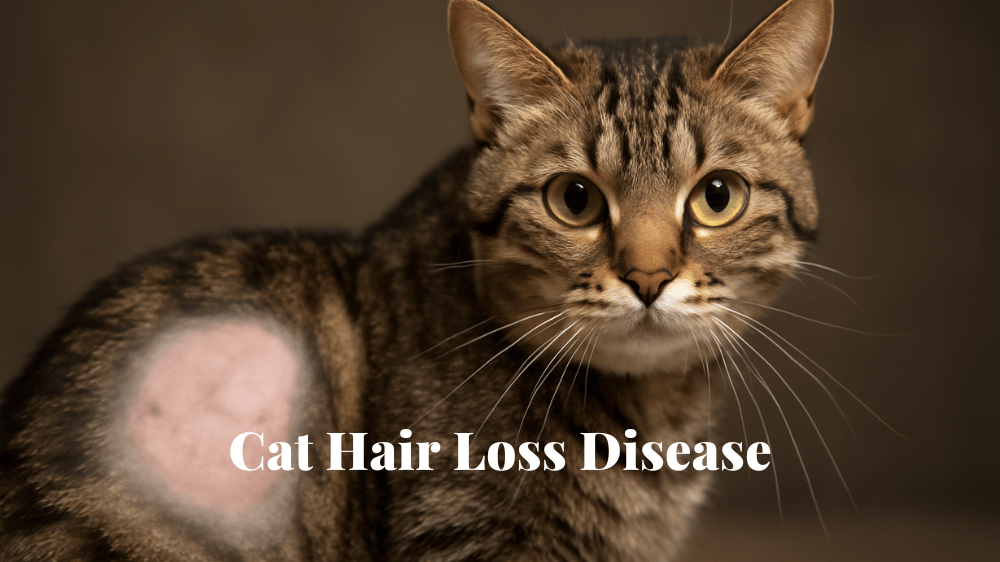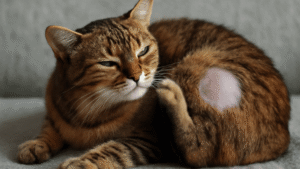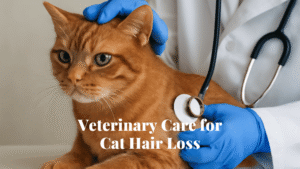If you have noticed a cat losing hair, it may be disheartening, but “cat hair loss disease” is stating the obvious. It’s normal for cats to shed, we all do, but excessive shedding in cats or sudden patch of hair loss in cats might lead to a health issue that requires medical attention. In this cat article, we’ll learn some of the reasons cats can begin to lose their hair, give you a few clues to look for – signs of cat hair loss – and also talk about how to know the difference between a cat losing a bit of fur now and then vs. true hair loss.
What Is Cat Hair Loss Disease?
The ”cat hair loss disease” is due to loss of hair by cats, which can be due to various reasons. Several of these “cat coat condition issues” are benign, but some are indicative of more serious health problems. Unlike typical shedding that is common with the natural growth period of the hair, a cat hair loss caused by disease will present as round bald patches, thinning fur or an increased “itching” or rubbing. The difference between hair loss and a cat shedding is important to understand, as it contributes to your cat’s health.
Signs of Cat Hair Loss and When to Worry
One of the first things you’ll wonder is, Why is my cat losing its fur? We will want to take note of signs of cat hair loss beyond the normal seasonal shed. If you see bald spots, or that your cat’s fur is looking thinner, or that there seems to be more fur in their bedding, it’s time to start looking a little closer. In cats, too much shedding could be an early symptom of cat alopecia, especially if you find redness, scabs or itching in the skin.
The difference between cat shedding vs. hair loss is that shedding is consistent and seasonal, while the latter is more localized and abnormal. If you are seeing clumps of fur coming out or if your cat is scratching themselves raw, then it’s time to dig deeper.
Common Cat Hair Loss Causes
There are several things that can cause “cat hair loss disease”, determining the cause is necessary for the right treatment. There is no single cause for cat hair loss. Below are the most common cat hair loss causes:
- Parasites: It’s common for fleas and mites to be responsible for cat hair loss. These little vampires annoy your cat’s skin and cause her to scratch and bite herself, which results in hair loss. Prevention is better than cure, and prevention is also relatively easy when it comes to preventing hair loss in cats.
- Allergies: Cats can also experience allergies to various food items, environmental factors or grooming products, like humans do. Inflammation, itching and hair loss can result from allergies. The root to putting a halt to cat hair loss due to sensitivities is by identifying the trigger.
- Skin Infections: Bacteria and Fungi could cause hair loss patches. If your cat’s skin is red, inflamed, or smelly, these are good signs that the infection is very strong and may need to be addressed by a vet.
- Stress and Anxiety: If your cat is stressed or anxious, they possibly may be over grooming and that can cause cat excessive shedding. Environmental changes, the addition of a new pet, or alterations in routine can cause this reaction.
- Hormonal Imbalances: Hormones such as hyperthyroidism and Cushing’s may also cause a cat’s coat to change, resulting in the coat to be thin or bald. These are not healthful conditions for the body, and thus, cat hair loss disease treatment needs to take place.
Cat Shedding vs. Hair Loss: A Comparison
There is a need to be able to distinguish cat shedding vs. hair loss to determine if the cat is likely going through a scheduled seasonal shed or if there’s something more serious taking place. Shedding is a normal part of cats’ lives and occurs when old fur is replaced by new growth — and it usually doesn’t lead to bald spots or patchy fur. In contrast, “cat hair loss disease” presents with prominent symptoms of cat hair loss, like large bald patches or areas of thinning hair.
So you can get a better sense of the difference here’s a bit of a comparison for you:
Table: Cat Shedding vs. Hair Loss
| Aspect | Cat Shedding | Cat Hair Loss |
| Cause | Natural process for new hair growth | Can be caused by underlying health issues |
| Appearance | Even shedding, small amounts of hair | Bald patches, thinning fur, excessive hair loss |
| Frequency | Occurs seasonally or throughout the year | Sudden and excessive loss of fur |
| Common Triggers | Seasonal changes, temperature fluctuations | Allergies, parasites, infections, stress |
| Treatment | Regular grooming and brushing | Veterinary care, parasite treatment, diet change |
| Consultation Needed | No need for a vet consultation | Yes, to rule out health problems |
Preventing and Treating Cat Hair Loss Disease
In order to protect your cat from “cat hair loss disease” you must make sure that its overall health is in good condition. A good diet in nutrients and balanced, helps the tone of their fur. If your cat is shedding hair because of allergies or because of parasites, then cat hair loss prevention is asking the vet about the best flea treatments and trying to move over to hypoallergenic foods or products.
When searching for information cat hair loss disease treatment first thing that comes to mind is veterinary care for cat hair loss. Your vet can make a diagnosis of the underlying problem — whether it’s stress, an infection, or a hormonal imbalance — and recommend an effective treatment. For instance, treatment in cases of cat hair loss due to parasites would include flea control whereas infections might call for antibiotics or antifungal medications.
When to Seek Veterinary Care for Cat Hair Loss
If your cat is experiencing hair loss along with other symptoms such as vomiting, weight loss or excessive scratching, it’s time to take a trip to the vet. Feline hair loss due to underlying issues such as kidney disease or diabetes The following condition of hair loss in cats must be treated professionally. Attempting to treat the problem at home might exacerbate it, she adds, so make sure you see your vet if you notice excessive shedding in cats or abnormal hair loss patterns.
Conclusion: Taking Action for Your Cat’s Health
If you have observed symptoms of cat hair loss, it is important to address it as soon as you notice it. “Cat hair loss disease” is frequently treatable or manageable when caught early. Whether your kitty is losing her hair due to stress, parasites, or an inflammatory condition, working with your vet to address cat hair loss causes and selecting the appropriate “cat hair loss disease treatment” will restore your cat’s health and her coat.
Frequently Asked Questions (FAQs) About Cat Hair Loss Disease
1. What is cat hair loss disease?
The “cat hair loss disease” is apparently excess hair loss which manifests for several reasons, allergies, parasites, infections, hormonal imbalances and more. Unlike the normal shedding that is part of a cat’s natural hair cycle, hair loss disease is characterized by visible bald patches, thinning fur, and excessive shedding.
2. How do I know if my cat’s hair loss is normal?
Healthy shedding is a seasonal process of normal fur loss in small amounts. Signs of cat hair loss to watch for include bald patches, patchy fur, excessive scratching, scabs or lesions. When you see some of these signs, it’s worth doing some more sleuthing.
3. What are the most common causes of cat hair loss?
The frequently occurring cat hair loss causes are parasites (fleas, mites), allergies, infections of the skin, stress, hormonal disorder, and malnutrition. Understanding the reason behind your cat’s hair loss is crucial when it comes to treating it.
4. Can cat hair loss be prevented?
Yes, the prevention of cat hair loss begins with good taking care of, including a nutritious balanced diet, regular grooming, and flea prevention. Strategies to minimize stress, control allergies, and keep your cat current on vaccinations and treatments can also aid in preventing “cat hair loss disease”.
5. What is the difference between cat shedding and hair loss?
Cat shedding is a natural phenomenon in which old hair is replaced by new growth in a systematic fashion. Cat hair loss, on the other hand, is the extreme or abnormal shedding of fur that can result in bald spots, thinning coat, and sores and signs of irritation. Cat shedding vs hair loss can be distinguished by bald spots and a lot of shedding.
6. How can stress cause hair loss in cats?
Indeed, too much stress can cause psychogenic alopecia – a scenario in which cats lick and scratch themselves due to stress, leading to bald patches. It’s also common for stress-related hair shedding to be fully or partially related to changes at home, new pets, or a break in a daily routine.
7. When should I take my cat to the vet for hair loss?
Although cats sometimes hide their alopecia (hair loss), that doesn’t mean that hair loss in cats is ever something to ignore: bald spots, overgrooming, pruritus, pain, etc. When to see a vet for hair loss in cats is always the safest course of action. Prompt intervention is critical to addressing the cause of the problem and avoiding future complications.
8. Can a poor diet cause hair loss in cats?
Yes, poor diet can result in cat hair thinning or excessive shedding. A diet low in nutrients like proteins, omega fatty acids, and vitamins can cause your cat’s skin to become dry and brittle and its fur to fall out. Some furballs could simply be due to a lack in your cat’s diet!
9. Can I treat my cat’s hair loss at home?
Although some light cat hair loss can be addressed through better grooming or diet, take your cat to the vet if she’s shedding in bucket loads. Treating “cat hair loss disease” on your own can make it worse.




